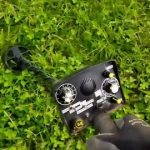Hand panning is a traditional method of gold prospecting that has been practiced for centuries. In this article, we will be exploring the art of hand panning for gold, discussing the techniques, tools, and skills required to successfully extract this precious metal from rivers and streams. Whether you are a beginner looking to try your hand at this age-old practice or a seasoned prospector honing your skills, this guide will provide valuable insights into the art of hand panning for gold.
Exploring the Art of Hand Panning for Gold is a popular hobby and recreational activity that involves using a shallow pan to separate gold particles from sediment. This traditional method of gold prospecting can be done in rivers and streams, and does not require expensive equipment or a permit. Hand panning for gold can be a rewarding and relaxing outdoor experience, and the thrill of finding even small amounts of gold can be a great incentive for many enthusiasts. Mastering the technique of hand panning requires patience and practice, but can be a fun and fulfilling way to connect with nature and potentially discover small amounts of gold.
Mastering the Art of Hand Panning for Gold

Mastering the Art of Hand Panning for Gold is a book written by Mark D. Jordan. This book provides a detailed guide on how to effectively pan for gold using only basic hand tools. It covers the history of gold panning, the techniques and methods used to find and extract gold, as well as tips and tricks for maximizing your chances of success. The book also includes information on the best locations for panning, safety considerations, and how to properly clean and store your gold once you’ve found it. Whether you’re a beginner or an experienced prospector, this book is a valuable resource for anyone looking to improve their hand panning skills.
Exploring the Basics of Hand Panning for Beginners

Exploring the Basics of Hand Panning for Beginners is designed to provide a comprehensive introduction to the art of hand panning for gold. The course covers essential techniques, equipment, and safety considerations for successful hand panning. Whether you are new to gold prospecting or looking to improve your skills, this course offers valuable insights and practical knowledge to help you get started. From understanding the properties of gold to mastering the proper hand panning motion, this course will equip you with the foundational knowledge and skills needed to begin your gold panning journey.
The History and Evolution of Hand Panning Techniques
See also: garrett detector gold

The history of hand panning dates back to ancient times, with evidence of simple hand panning techniques being used by civilizations such as the ancient Egyptians and Romans. In more recent history, hand panning became popular during the California Gold Rush in the mid-19th century, where prospectors would use basic tools such as pans and shovels to sift through sediment in search of gold.
Over time, the techniques and tools used for hand panning have evolved, with advancements such as the rocker box and sluice box being introduced to make the process more efficient. In addition, modern hand panning enthusiasts have developed more specialized methods for targeting specific types of gold deposits, such as crevicing and sniping.
Today, hand panning continues to be a popular hobby and recreational activity for people interested in prospecting for gold. While technological advancements have led to the development of more efficient methods of gold prospecting, hand panning remains a traditional and rewarding way to experience the thrill of finding gold in natural settings.
Reviving the Age-Old Tradition of Hand Panning

Reviving the age-old tradition of hand panning involves the practice of manually extracting gold from riverbeds or other sediment deposits using a simple pan. This method was historically used during the California Gold Rush and in various other gold mining operations around the world. Today, there is a renewed interest in hand panning as a recreational activity and as a way for small-scale miners to access gold deposits without the use of heavy machinery. Hand panning requires skill and patience, but it offers a direct and intimate connection to the natural environment and the history of gold mining.
Tips and Tricks for Successful Hand Panning Adventures
• Find a suitable location with a good amount of water flow and some gravelly areas.
• Use a lightweight and portable gold pan that is easy to handle and carry.
• Take your time and be patient while panning, as it can be a slow and meticulous process.
• Use a gentle and repetitive shaking motion to separate the gold from the other materials in the pan.
• Keep an eye out for black sand, as this is often an indicator of potential gold deposits.
• Bring along a snuffer bottle to easily collect any small gold flakes or nuggets that you may find.
• Consider using a classifier to help sift out larger rocks and debris before panning.
• Pay attention to the water flow and direction to effectively wash away lighter materials and concentrate the heavier gold at the bottom of the pan.
• Be respectful of the environment and follow any regulations or guidelines for hand panning in your area.
The Thrill of Finding Gold Through Hand Panning
“The Thrill of Finding Gold Through Hand Panning” refers to the traditional method of prospecting for gold using a shallow pan to separate the precious metal from sediment and gravel. This method has been used for centuries and continues to be a popular recreational activity for gold enthusiasts. Hand panning can be done in rivers, streams, and other water sources where gold deposits may be present. It requires patience, skill, and a keen eye for spotting small traces of gold among the material being sifted. The thrill of finding gold through hand panning comes from the anticipation and excitement of uncovering a valuable and rare treasure from nature. It offers a sense of adventure and the satisfaction of successfully extracting gold using only basic tools and techniques. Overall, hand panning for gold provides a unique and rewarding experience for those who enjoy outdoor activities and the pursuit of valuable minerals.
The Science Behind Effective Hand Panning Methods
The science behind effective hand panning methods involves understanding the principles of gravity, fluid dynamics, and particle behavior. When panning for gold or other valuable minerals, the aim is to separate the heavier particles from the lighter ones. This is achieved by utilizing the natural force of gravity to allow heavier materials to settle to the bottom of the pan, while the lighter materials are carried away with the water.
Additionally, understanding the behavior of particles in a fluid medium is crucial. By carefully agitating the mixture of water and sediment in the pan, it is possible to create a classification effect, where larger particles settle first, followed by smaller and lighter particles. This process allows for the efficient separation of valuable materials from the rest of the sediment.
Furthermore, the design and shape of the pan play a significant role in its effectiveness. The shape of the pan, the depth of the riffles, and the angle at which it is held all contribute to the overall efficiency of the panning process. These factors are all informed by the underlying scientific principles that govern the behavior of particles in a fluid medium.
In conclusion, effective hand panning methods rely on a solid understanding of gravity, fluid dynamics, and particle behavior. By applying these principles, panners can improve their chances of successfully separating valuable materials from the surrounding sediment.
Preserving the Environment While Hand Panning for Gold
When hand panning for gold, it is important to be mindful of the impact on the environment. One way to preserve the environment while pursuing this activity is to use biodegradable and environmentally friendly soaps when cleaning equipment and washing hands. Additionally, it is crucial to properly dispose of any waste generated during the panning process and to avoid damaging or disturbing any natural habitats. It is also important to adhere to any local regulations or guidelines for gold panning in order to minimize negative effects on the environment.
The Growing Popularity of Hand Panning in Modern Times
Hand panning, a traditional gold mining method using a pan to wash gravel from riverbeds or streams to find small particles of gold, has been experiencing a resurgence in modern times. This revival can be attributed to a growing interest in outdoor activities, historical skills, and the allure of discovering valuable treasure on one’s own. Additionally, hand panning is seen as a sustainable and environmentally friendly way of mining for gold, as it does not require the use of heavy machinery or chemicals. Many people also find the process of hand panning to be a meditative and relaxing experience, making it a popular hobby for individuals seeking a unique and rewarding outdoor activity. As a result, hand panning has gained popularity among people of all ages and backgrounds who are drawn to the excitement of prospecting and the potential for finding valuable gold.
Taking on the Challenge of Hand Panning in Remote Locations
Taking on the Challenge of Hand Panning in Remote Locations involves venturing into remote areas with basic tools to look for gold. Hand panning requires skill and patience, as well as knowledge of where to look for the best gold deposits. It can be physically demanding and requires an understanding of the geology of the area. Additionally, being in a remote location means being self-sufficient and prepared for any emergencies that may arise. Overall, hand panning in remote locations is a unique and challenging experience that can be rewarding for those who are up for the adventure.












